1997 ACURA NSX suspension
[x] Cancel search: suspensionPage 937 of 1503
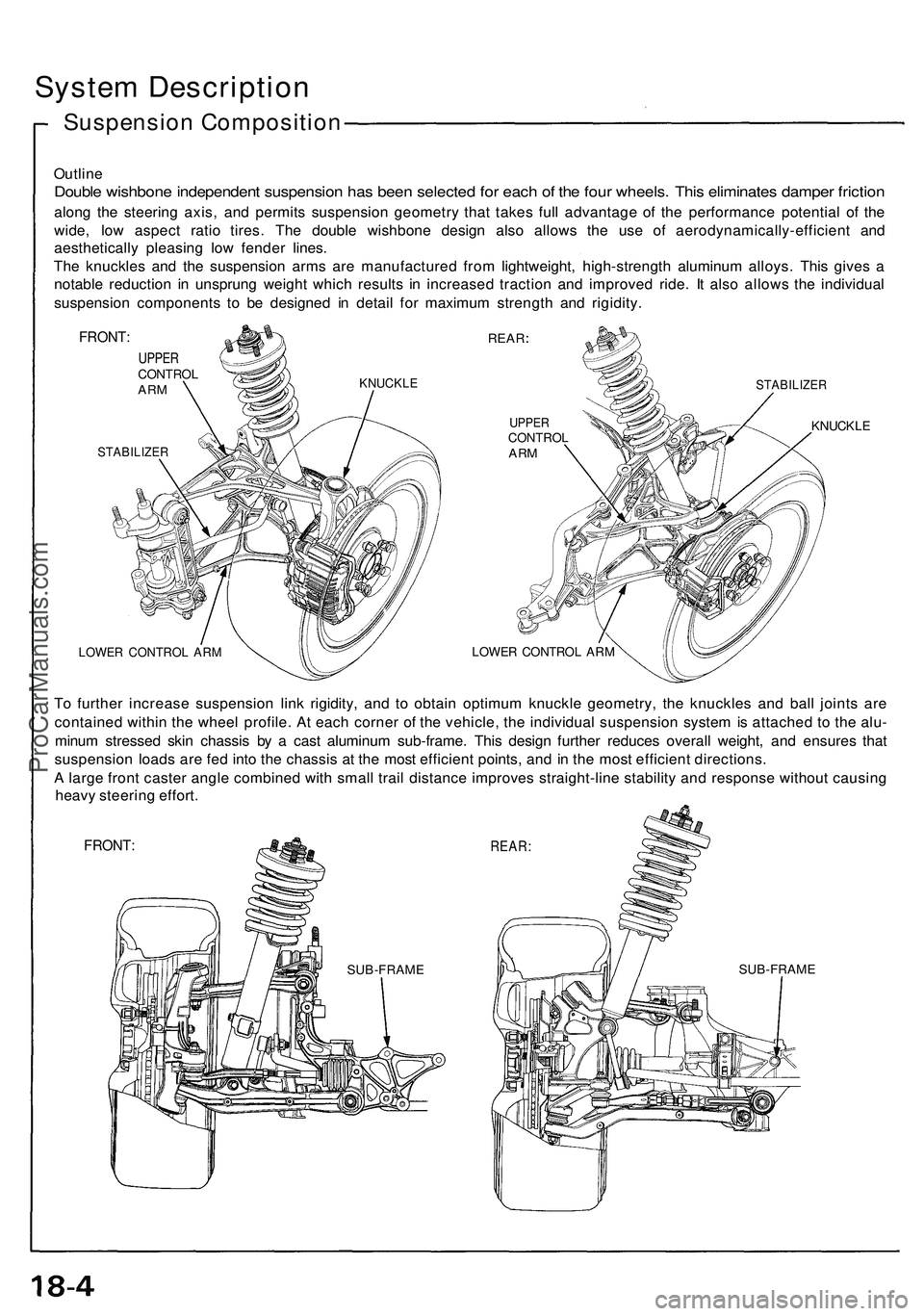
System Description
Suspension Composition
Outline
Double wishbon e independen t suspensio n ha s bee n selecte d fo r eac h o f th e fou r wheels . Thi s eliminate s dampe r frictio n
along th e steerin g axis , an d permit s suspensio n geometr y tha t take s ful l advantag e o f th e performanc e potentia l o f th e
wide , lo w aspec t rati o tires . Th e doubl e wishbon e desig n als o allow s th e us e o f aerodynamically-efficien t an d
aestheticall y pleasin g lo w fende r lines .
Th e knuckle s an d th e suspensio n arm s ar e manufacture d fro m lightweight , high-strengt h aluminu m alloys . Thi s give s a
notabl e reductio n i n unsprun g weigh t whic h result s i n increase d tractio n an d improve d ride . I t als o allow s th e individua l
suspensio n component s t o b e designe d i n detai l fo r maximu m strengt h an d rigidity .
FRONT:
UPPERCONTRO LARMKNUCKL E
STABILIZE R
REAR
STABILIZE R
UPPERCONTRO LARM
LOWE R CONTRO L AR M
KNUCKL E
LOWER CONTRO L AR M
To furthe r increas e suspensio n lin k rigidity , an d t o obtai n optimu m knuckl e geometry , th e knuckle s an d bal l joint s ar e
containe d withi n th e whee l profile . A t eac h corne r o f th e vehicle , th e individua l suspensio n syste m is attache d t o th e alu -
minu m stresse d ski n chassi s b y a cas t aluminu m sub-frame . Thi s desig n furthe r reduce s overal l weight , an d ensure s tha t
suspensio n load s ar e fe d int o th e chassi s a t th e mos t efficien t points , an d i n th e mos t efficien t directions .
A larg e fron t caste r angl e combine d wit h smal l trai l distanc e improve s straight-lin e stabilit y an d respons e withou t causin g
heav y steerin g effort .
FRONT :REAR:
SUB-FRAM ESUB-FRAM E
ProCarManuals.com
Page 938 of 1503
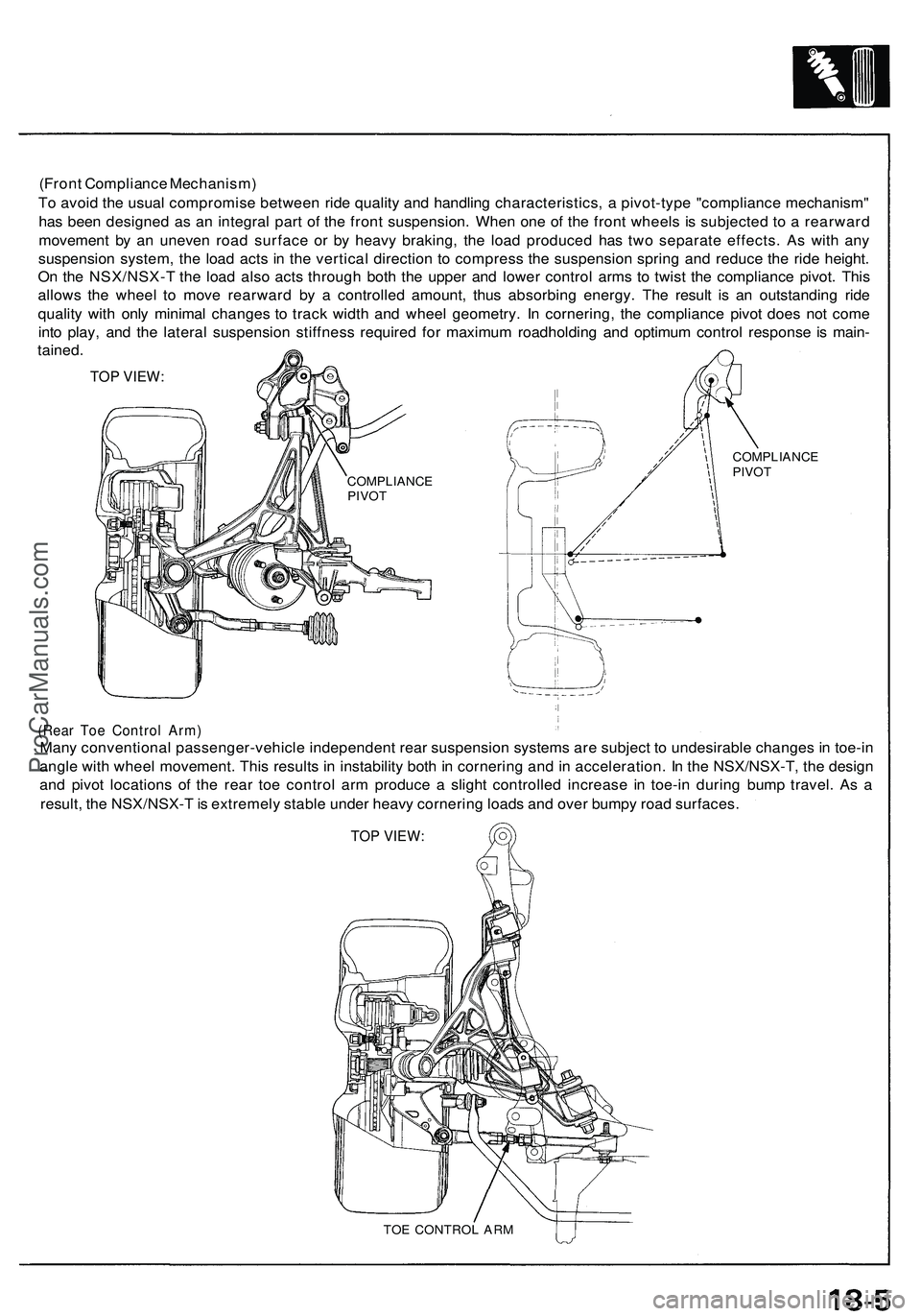
(Front Compliance Mechanism)
To avoid the usual compromise between ride quality and handling characteristics, a pivot-type "compliance mechanism"
has been designed as an integral part of the front suspension. When one of the front wheels is subjected to a rearward
movement by an uneven road surface or by heavy braking, the load produced has two separate effects. As with any
suspension system, the load acts in the vertical direction to compress the suspension spring and reduce the ride height.
On the NSX/NSX-T the load also acts through both the upper and lower control arms to twist the compliance pivot. This
allows the wheel to move rearward by a controlled amount, thus absorbing energy. The result is an outstanding ride
quality with only minimal changes to track width and wheel geometry. In cornering, the compliance pivot does not come
into play, and the lateral suspension stiffness required for maximum roadholding and optimum control response is main-
tained.
TOP VIEW:
(Rear Toe Control Arm)
Many conventional passenger-vehicle independent rear suspension systems are subject to undesirable changes in toe-in
angle with wheel movement. This results in instability both in cornering and in acceleration. In the NSX/NSX-T, the design
and pivot locations of the rear toe control arm produce a slight controlled increase in toe-in during bump travel. As a
result, the NSX/NSX-T is extremely stable under heavy cornering loads and over bumpy road surfaces.
TOP VIEW:
TOE CONTROL ARM
COMPLIANCE
PIVOT
COMPLIANCE
PIVOTProCarManuals.com
Page 939 of 1503
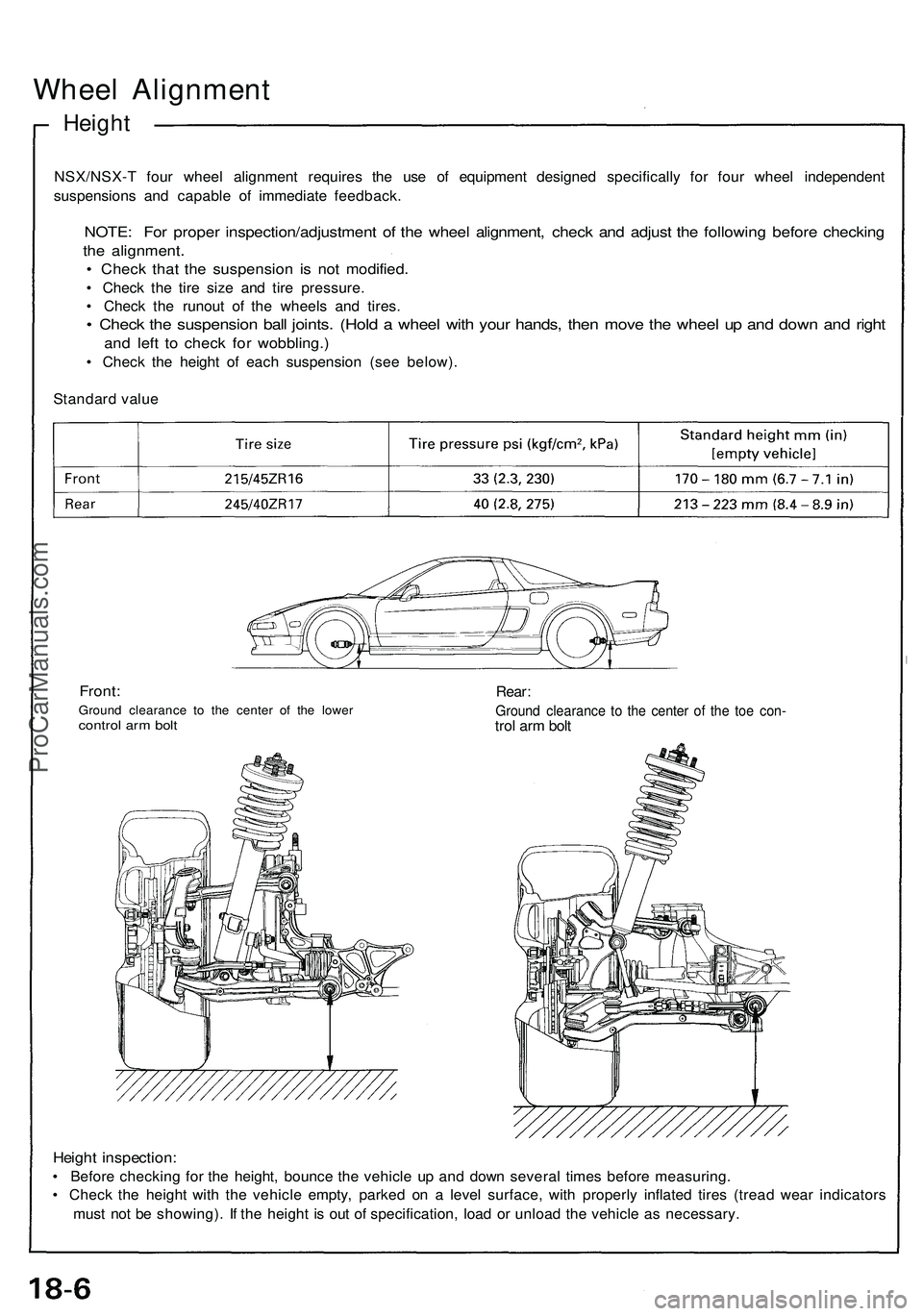
Wheel Alignment
Height
NSX/NSX-T four wheel alignment requires the use of equipment designed specifically for four wheel independent
suspensions and capable of immediate feedback.
NOTE: For proper inspection/adjustment of the wheel alignment, check and adjust the following before checking
the alignment.
• Check that the suspension is not modified.
• Check the tire size and tire pressure.
• Check the runout of the wheels and tires.
• Check the suspension ball joints. (Hold a wheel with your hands, then move the wheel up and down and right
and left to check for wobbling.)
• Check the height of each suspension (see below).
Standard value
Front:
Ground clearance to the center of the lower
control arm bolt
Rear:
Ground clearance to the center of the toe con-
trol arm bolt
Height inspection:
• Before checking for the height, bounce the vehicle up and down several times before measuring.
• Check the height with the vehicle empty, parked on a level surface, with properly inflated tires (tread wear indicators
must not be showing). If the height is out of specification, load or unload the vehicle as necessary.ProCarManuals.com
Page 940 of 1503
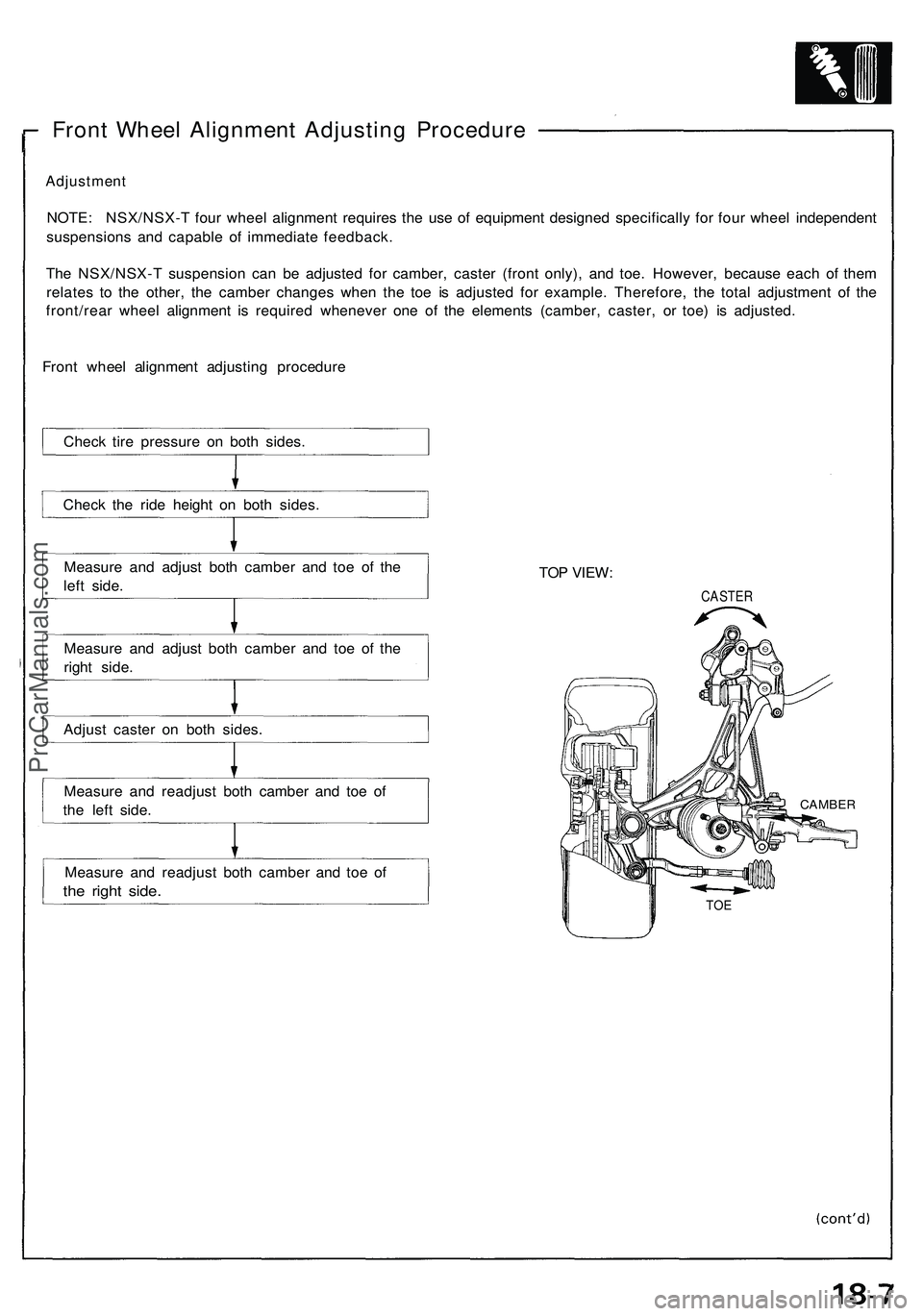
Front Wheel Alignment Adjusting Procedure
Adjustment
NOTE: NSX/NSX-T four wheel alignment requires the use of equipment designed specifically for four wheel independent
suspensions and capable of immediate feedback.
The NSX/NSX-T suspension can be adjusted for camber, caster (front only), and toe. However, because each of them
relates to the other, the camber changes when the toe is adjusted for example. Therefore, the total adjustment of the
front/rear wheel alignment is required whenever one of the elements (camber, caster, or toe) is adjusted.
Front wheel alignment adjusting procedure
Measure and adjust both camber and toe of the
left side.
Measure and adjust both camber and toe of the
right side.
Adjust caster on both sides.
Measure and readjust both camber and toe of
the left side.
Measure and readjust both camber and toe of
the right side.
TOP VIEW:
CASTER
TOE
CAMBER
Check tire pressure on both sides.
Check the ride height on both sides.ProCarManuals.com
Page 941 of 1503

Wheel Alignmen t
Front Whee l Alignmen t Adjustmen t Procedur e
NOTE:
• NSX/NSX- T fou r whee l alignmen t require s th e us e o f
equipmen t designe d specificall y fo r fou r whee l in -
dependen t suspension s an d capabl e of immediat e
feedback.
• Th e rid e heigh t i s ver y importan t fo r settin g th e align -
ment . Fo r ever y 1 0 m m (0. 4 in ) of chang e i n th e
fron t rid e height , th e cambe r wil l chang e approx -
imately 1 0 minutes .
• Th e fron t alignmen t setting s o n th e NS X ar e
interactive .
• A sligh t chang e i n to e wil l dramaticall y chang e th e
camber .
• Alway s inspec t an d adjus t th e fron t whee l alignmen t
wit h th e steerin g whee l i n th e straigh t ahea d
position .
1. Driv e th e vehicl e o n th e alignmen t rack .
2 . Chec k th e tir e pressur e an d rid e heigh t (se e pag e
18-6 ).
3 . Cente r th e steerin g whee l i n th e straigh t ahea d
position , an d loc k i t i n plac e wit h th e steerin g lock .
4 . Se t th e alignmen t equipmen t followin g th e
manufacturer' s instructions .
5 . Measur e an d adjus t th e cambe r an d to e o n th e lef t
side , the n measur e an d adjus t th e righ t side .
Toe:
— Loose n th e locknut , an d tur n th e righ t an d lef t
tie-rod s t o adjus t th e fron t toe .
LOCKNU T43 N- m(4.4 kgf-m , 3 2 Ibf-ft )TIE-RO D
Camber :
— Loose n th e self-lockin g nu t o n th e fron t lowe r
contro l ar m adjustin g point , an d adjus t th e
cambe r b y turnin g th e adjustin g cam .
SELF-LOCKIN G NU TReplace .123 N- m(12. 5 kgf-m , 9 0 Ibf-ft )
Corrosio n resistan t bolt/nu t
ADJUSTIN G CA M
ProCarManuals.com
Page 943 of 1503
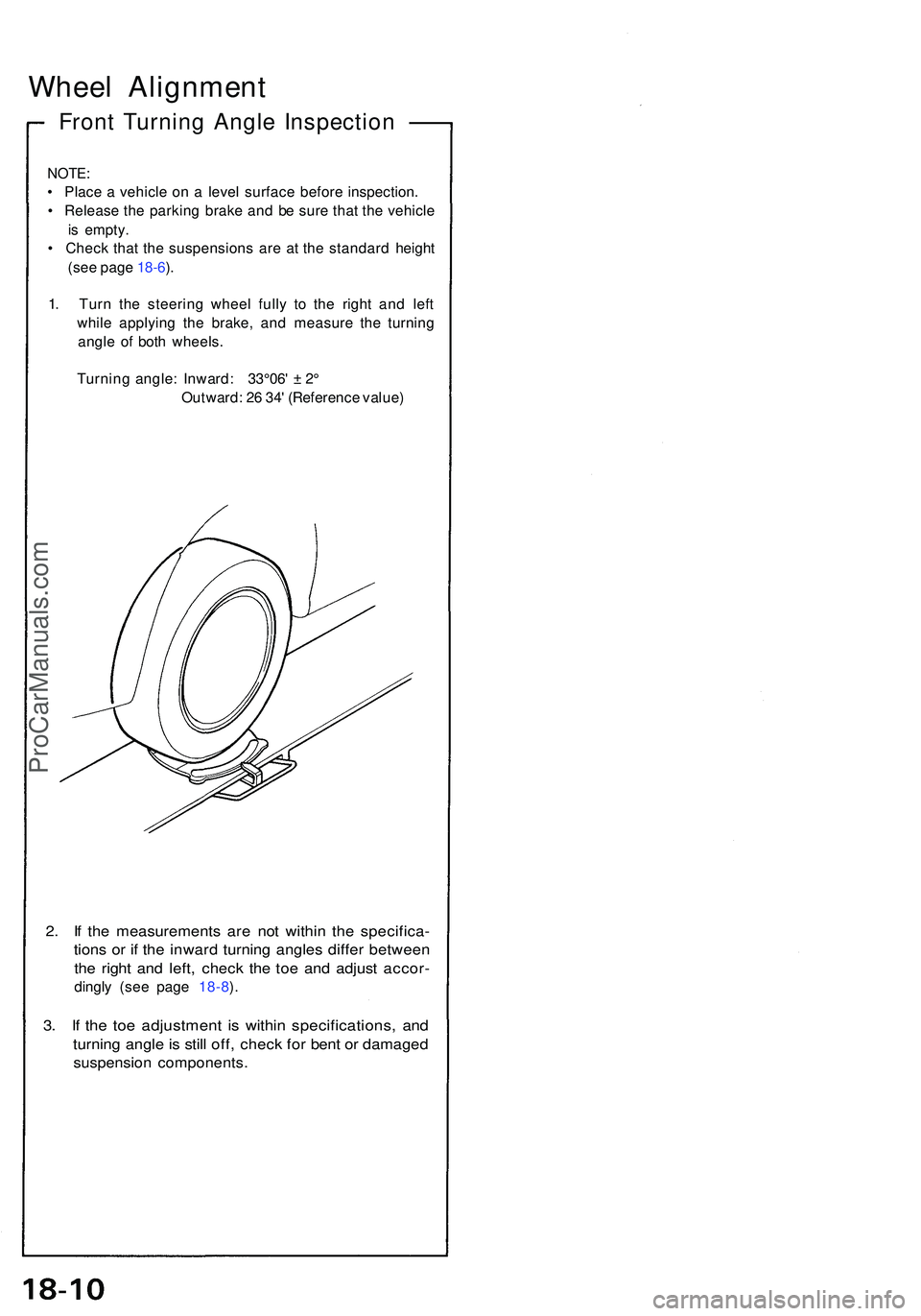
Wheel Alignmen t
Front Turnin g Angl e Inspectio n
NOTE:
• Plac e a vehicl e o n a leve l surfac e befor e inspection .
• Releas e th e parkin g brak e an d b e sur e tha t th e vehicl e
i s empty .
• Chec k tha t th e suspension s ar e a t th e standar d heigh t
(se e pag e 18-6 ).
1 . Tur n th e steerin g whee l full y t o th e righ t an d lef t
whil e applyin g th e brake , an d measur e th e turnin g
angl e o f bot h wheels .
Turnin g angle : Inward : 33°06 ' ± 2°
Outward : 2 6 34 ' (Referenc e value )
2. I f th e measurement s ar e no t withi n th e specifica -
tions o r i f th e inwar d turnin g angle s diffe r betwee n
the righ t an d left , chec k th e to e an d adjus t accor -
dingly (se e pag e 18-8 ).
3 . I f th e to e adjustmen t i s withi n specifications , an d
turnin g angl e is stil l off , chec k fo r ben t o r damage d
suspensio n components .
ProCarManuals.com
Page 945 of 1503
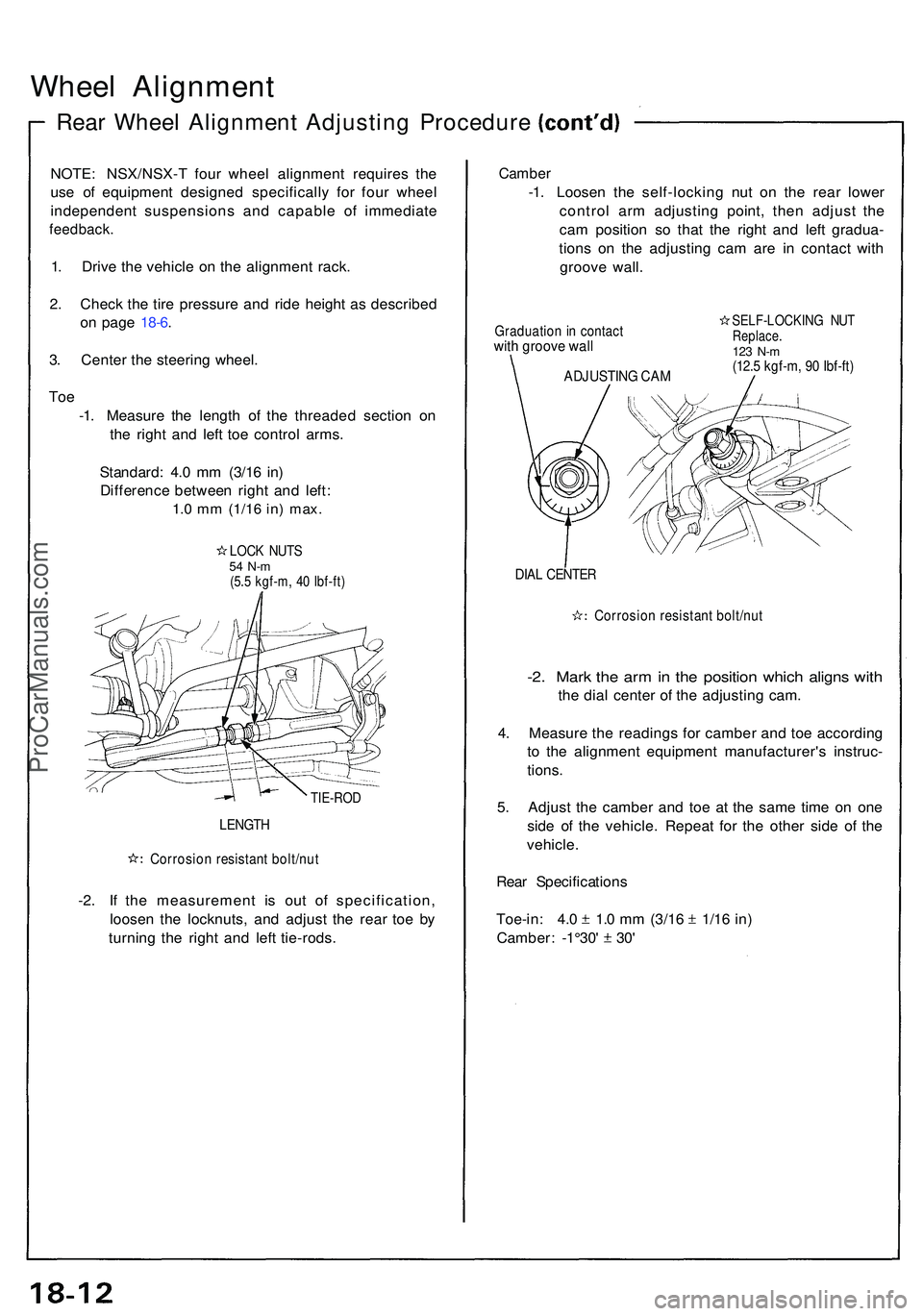
Wheel Alignmen t
Rear Whee l Alignmen t Adjustin g Procedur e
NOTE: NSX/NSX- T fou r whee l alignmen t require s th e
us e o f equipmen t designe d specificall y fo r fou r whee l
independen t suspension s an d capabl e o f immediat e
feedback.
1. Driv e th e vehicl e o n th e alignmen t rack .
2 . Chec k th e tir e pressur e an d rid e heigh t a s describe d
o n pag e 18-6 .
3 . Cente r th e steerin g wheel .
Toe
-1. Measur e th e lengt h o f th e threade d sectio n o n
th e righ t an d lef t to e contro l arms .
Standard : 4. 0 m m (3/1 6 in )
Differenc e betwee n righ t an d left :
1.0 m m (1/1 6 in) max .
LOCK NUT S54 N- m(5.5 kgf-m , 4 0 Ibf-ft )
TIE-RO D
LENGTH
Corrosio n resistan t bolt/nu t
-2. I f th e measuremen t i s ou t o f specification ,
loose n th e locknuts , an d adjus t th e rea r to e b y
turnin g th e righ t an d lef t tie-rods .
Camber
-1. Loose n th e self-lockin g nu t o n th e rea r lowe r
contro l ar m adjustin g point , the n adjus t th e
ca m positio n s o tha t th e righ t an d lef t gradua -
tion s o n th e adjustin g ca m ar e i n contac t wit h
groov e wall .
Graduatio n i n contac twith groov e wal l
SELF-LOCKIN G NU TReplace .123 N- m(12. 5 kgf-m , 9 0 Ibf-ft )
DIAL CENTE R
Corrosio n resistan t bolt/nu t
-2. Mar k th e ar m in th e positio n whic h align s wit h
the dia l cente r o f th e adjustin g cam .
4 . Measur e th e reading s fo r cambe r an d to e accordin g
t o th e alignmen t equipmen t manufacturer' s instruc -
tions .
5 . Adjus t th e cambe r an d to e a t th e sam e tim e o n on e
sid e o f th e vehicle . Repea t fo r th e othe r sid e o f th e
vehicle .
Rea r Specification s
Toe-in: 4. 0 1. 0 m m (3/1 6 1/1 6 in )
Camber : -1°30 ' 30 '
ADJUSTIN G CA M
ProCarManuals.com